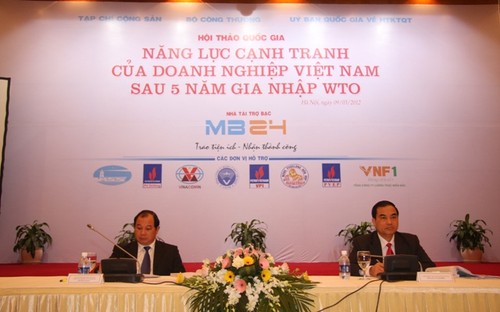 |
| A national conference on Vietnamese enterprises' competitive edge after 5 years of WTO membership. Photo: www.vccinews.com |
(VOV) Since Vietnam joined the World Trade Organization 5 years ago, its export market has expanded to 149 countries but many challenges still face its integration process. At a recent seminar, economists and policy-makers agreed that Vietnam needs to make drastic institutional changes to fully integrate into the regional and global economies.
Luong Van Tu, former Deputy Trade Minister and chief negotiator for Vietnam’s WTO entry, says membership has created a new legal basis on which to develop a complete market economy. This can be clearly seen in the new way entrepreneurs think about penetrating the world market and exports in the revenue, which has grown 98% in 5 years. Last year, Vietnam earned 97 billion USD from selling goods abroad. Distribution and retail services have grown robustly, with numerous supermarkets, shopping malls, and convenience stores opening throughout the country. WTO membership move has changed the consuming habits of the Vietnamese people and contributed enormously to Vietnam’s economic growth. Mr. Tu elaborates 'At the beginning of WTO negotiations, the average per-capita income in Vietnam was 400 USD a year. By the end of the process, this had increased to 1,000 USD and is now 1,200 USD. The rise is attributable to the efforts of everyone, especially enterprises which have made full use of the opening of the market to increase and call for investment. Foreign investment capital has jumped to 60 billion USD'.
But many challenges remain particularly the pressure of increased competition in domestic and global markets. Mr. Tu says Vietnamese companies haven’t made the most of WTO membership. Senior economist Pham Chi Lan points to three hurdles – improving institutions, developing human resources and building infrastructure which must be cleared to increase Vietnam’s competitive edge.
In a more positive vein, Dr Dinh Thi My Loan, General Secretary of the Vietnam Retailers Association, points out that Vietnam’s retail industry has made a lot of progress in 5 years. Domestic retailers contributed 13.32% to the GDP in 2005 and the figure grew to 14.43% by 2010. Modern retail continues to expand rapidly in Vietnam with the establishment of hundreds of supermarkets and shopping centers. By the end of 2010, Vietnam had nearly 8,600 markets of various kinds. Ms Loan says that despite the rapid growth of the retail sector, the retail market is still fragmented and small scale with weak purchasing power. She adds 'Vietnam should increase professionalism to meet new standards and keep up with retail trends in the rest of the world. The improvement should be particularly focused on retail sale skills'.